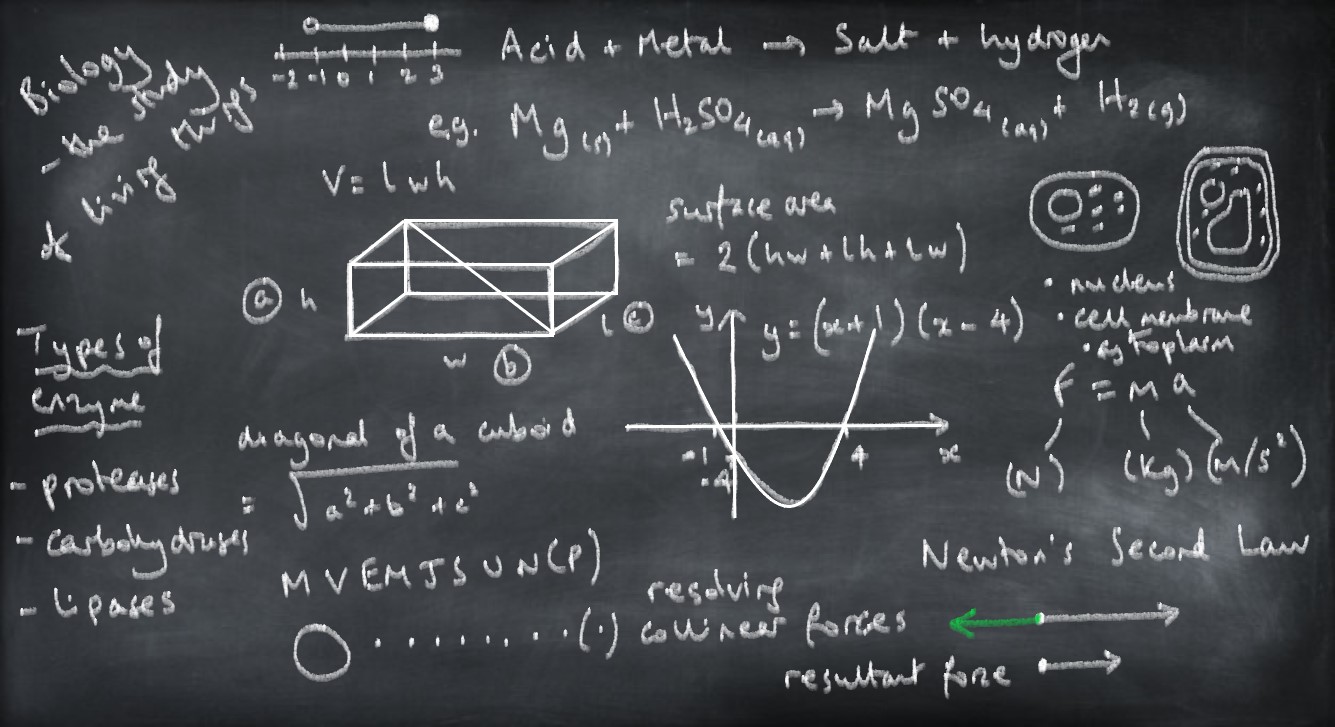Private Tutor Offering One-To-One / Online Tuition
Students in most state schools follow a Combined Science course, leading to two Science GCSEs at grade 9-1. Top sets, and classes in grammar and many independent schools usually follow three separate Science courses. The content of Combined Science Biology is about two-thirds that of the individual GCSE Biology course.
Foundation Tier gives students the opportunity to attain grades up to Grade 5 (a good pass). Higher Tier gives students the opportunity to attain grades up to Grade 9. The most popular exam board is currently AQA, which runs the Science Trilogy course.
Two end-of-course exams need to be taken at the end of the course. For Combined Science students these are 1 hr 15mins each, whilst for Biology GCSE students these are 1 hr 45 mins each. Students must gain the practical endorsement from the exam centre at which they sit the written papers.
Some private candidates, independent and international school students follow iGCSE Biology, or iGCSE Combined Science. These are international GCSE qualifications and may be taken without the need for the practical skills endorsement. Edexcel and CIE are popular exam boards for this qualification.
Students in most state schools follow a Combined Science course, leading to two Science GCSEs at grade 9-1. Top sets, and classes in grammar and many independent schools usually follow three separate Science courses. The content of Combined Science Chemistry is about two-thirds that of the individual GCSE Chemistry course.
Foundation Tier gives students the opportunity to attain grades up to Grade 5 (a good pass). Higher Tier gives students the opportunity to attain grades up to Grade 9. The most popular exam board is currently AQA, which runs the Science Trilogy course.
Two end-of-course exams need to be taken at the end of the course. For Combined Science students these are 1 hr 15mins each, whilst for Chemistry GCSE students these are 1 hr 45 mins each. Students must gain the practical endorsement from the exam centre at which they sit the written papers.
Some private candidates, independent and international school students follow iGCSE Chemistry, or iGCSE Combined Science. These are international GCSE qualifications and may be taken without the need for the practical skills endorsement. Edexcel and CIE are popular exam boards for this qualification.
Students in most state school follow a Combined Science course, leading to two Science GCSEs at grade 9-1. Top sets, and classes in grammar and many independent schools usually follow three separate Science courses. The content of Combined Science Physics is about two-thirds that of the individual GCSE Physics course.
Foundation Tier gives students the opportunity to attain grades up to Grade 5 (a good pass). Higher Tier gives students the opportunity to attain grades up to Grade 9. The most popular exam board is currently AQA, which runs the Science Trilogy course.
Two end-of-course exams need to be taken at the end of the course. For Combined Science students these are 1 hr 15mins each, whilst for Physics GCSE students these are 1 hr 45 mins each. Students must gain the practical endorsement from the exam centre at which they sit the written papers.
Some private candidates, independent and international school students follow iGCSE Physics, or iGCSE Combined Science. These are international GCSE qualifications and may be taken without the need for the practical skills endorsement. Edexcel and CIE are popular exam boards for this qualification.
Maths is examined by three end-of-course exams at either Foundation Tier (Grades 1-5) or Higher Tier (Grades 4-9). These consist of a non-calculator Paper, in which calculators are not permitted, and two calculator Papers.
The most popular exam boards are currently Edexcel and AQA.
Some independent school, international school students and private candidates take iGCSE Maths, which has some additional content. Edexcel and CIE are popular exam boards.
Top set students may also take a further Maths qualification, such as AQA Level 2 Certificate Further Maths.
AQA Level 2 Certificate Further Maths is an example of a qualification taken by some top set students aiming for at least Grade 7 in GCSE Maths who are likely to continue their studies of mathematics at A-level. Most topics tested are those only Higher Tier GCSE Maths candidates will be familiar with, and there are additional topics not included in GCSE Maths that overlap with A-level content. Students who do well in Level 2 Further Maths are at a significant advantage at the start of their A-level Maths courses due to this extra exposure to advanced concepts, and more in-depth coverage of material.
Most students wanting to study medicine, veterinary science, or any of several biological science-based disciplines at university will study Biology at A-level. In the UK, the main exam boards are AQA, OCR and Edexcel. International and independent schools may alternatively offer International Baccalaureate or international A-levels in Biology, with CIE and Edexcel being common exam boards for the latter.
The grounding in biological molecules, cell biology, physiology and organ systems, homeostasis, organ-focused study, co-ordination and response, ecology, genetics, evolution and biotechnology are explored in much greater detail at A-level. Students develop their critical and analytical skills, interpreting evidence, and extending their abilities to describe, explain and evaluate information, as well as suggest reasons for observed results. As time goes on, more content trickles down into A-level Biology specifications from university-level study as scientific breakthroughs in biological science become incorporated into the education of our children.
Most students wanting to study Economics, Accounting, Finance, or any of several numeracy-based disciplines at university will study Maths at A-level. In the UK, the main exam boards are AQA, OCR and Edexcel. International and independent schools may alternatively offer International Baccalaureate or international A-levels in Maths, with CIE and Edexcel being common exam boards for the latter.
Students of A-level Maths are expected to be able to absorb 2 years of Maths and sit 3 end-of-course assessments to determine their grade, in Pure Maths (two-thirds of most courses), Statistics (one-sixth) and Mechanics (another sixth). Statistics and Mechanics are often referred to as Applied Maths, as they are more obviously readily applicable to the world around us. Pure Maths, however, underpins much of the digital age we are now in, and a solid grounding in Maths is essential for much scientific study at university.

